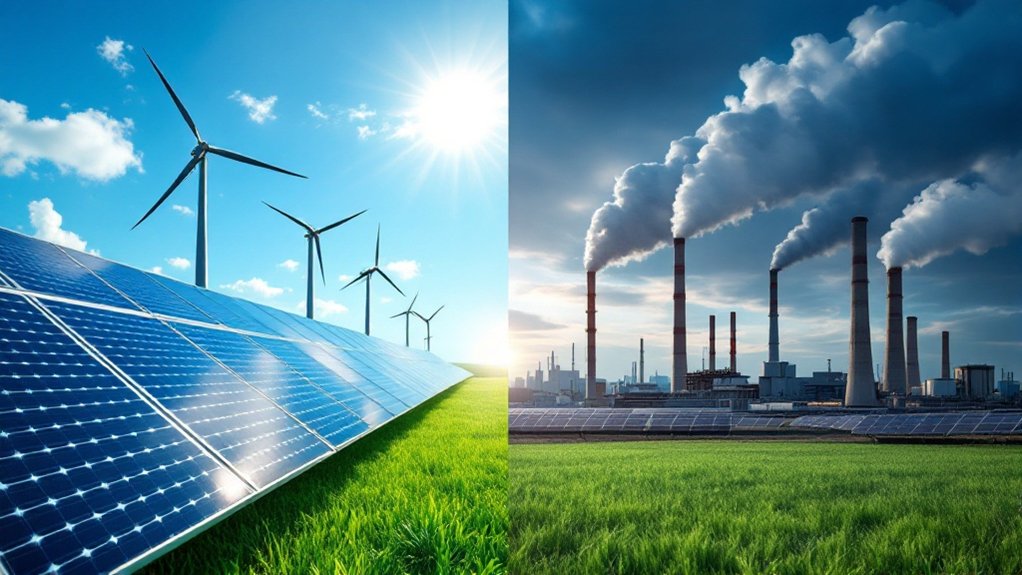The debate between decarbonization strategies and traditional emission reduction methods is gaining traction. Traditional approaches often emphasize incremental changes, yet these may not suffice to meet the urgent climate objectives ahead. In contrast, decarbonization techniques promise transformative shifts through innovative technologies. This raises critical questions about effectiveness and adaptability. As the need for sustainable solutions intensifies, exploring the synergy between these strategies becomes imperative. What combination might lead to the most impactful outcomes?
Understanding Traditional Emission Reduction Strategies
While many organizations seek innovative solutions for emission reduction, traditional strategies remain foundational in combating climate change. These established methods focus on enhancing energy efficiency, shifting to renewable energy sources, and implementing regulatory measures to limit emissions. Energy efficiency improvements often involve upgrading infrastructure and adopting technologies that consume less power. Moving to renewable energy includes investing in solar, wind, and hydroelectric systems, which generate power without emitting greenhouse gases. Regulatory measures, such as carbon pricing and emission standards, compel industries to reduce their carbon footprint. Together, these traditional strategies form a broad framework for emission reduction, driving significant progress in mitigating climate change impacts. Understanding their role is vital before exploring newer, innovative techniques that may complement these foundational approaches. Additionally, implementing these strategies can lead to significant cost savings for households and businesses, enhancing overall economic stability.
The Rise of Decarbonization Techniques
Decarbonization techniques have emerged as essential tools in the global effort to combat climate change. These methods focus on reducing greenhouse gas emissions through innovative approaches, such as carbon capture and storage, renewable energy adoption, and energy efficiency improvements. Industries are increasingly recognizing the importance of shifting to low-carbon operations, driven by regulatory pressures, societal expectations, and the need for sustainable practices. Moreover, advancements in technology have facilitated the development of more effective solutions, making decarbonization more accessible than ever before. Companies are also investing in research and development to explore new techniques that could additionally decrease their carbon footprints. As awareness of climate issues grows, decarbonization techniques are expected to play a crucial role in shaping a sustainable future. Robust policy frameworks are essential to harness the full potential of innovation in deep decarbonization.
Comparing Effectiveness: Traditional vs. Decarbonization Approaches
How do traditional strategies hold up against modern decarbonization approaches in the quest for sustainability? Traditional strategies often focus on incremental improvements, such as enhancing energy efficiency and optimizing existing systems. While these methods can yield moderate results, they may struggle to meet the aggressive emission reduction targets set by global initiatives. In contrast, decarbonization approaches advocate for transformative changes, including the adoption of renewable energy sources, electrification, and innovative technologies. These methods prioritize long-term sustainability over short-term gains, offering a more thorough solution to climate challenges. Evaluating their effectiveness reveals that while traditional strategies play a role, decarbonization approaches are increasingly recognized as essential for achieving significant and lasting reductions in greenhouse gas emissions, positioning them as the preferred choice for future sustainability efforts. Furthermore, the integration of technology is pivotal for facilitating the transition to a low-carbon energy system.
Case Studies: Success Stories in Emission Reductions
Successful case studies across various sectors illustrate the potential of innovative strategies in achieving significant emission reductions. One prominent example is the energy sector, where a leading utility company implemented a thorough renewable energy plan, resulting in a 40% reduction in carbon emissions within five years. In the transportation industry, a major logistics firm adopted electric vehicles and optimized routing, cutting emissions by 30%. Additionally, a large manufacturing facility integrated energy-efficient technologies and waste-to-energy systems, achieving a 25% decrease in their carbon footprint. These examples demonstrate that through targeted initiatives and a commitment to sustainability, organizations can effectively reduce emissions while maintaining operational efficiency and profitability. Such success stories provide valuable insights into the practical applications of emission reduction strategies. Furthermore, California’s commitment to renewable energy will drive the transformation needed for a sustainable energy future.
Future Outlook: Integrating Both Strategies for a Sustainable Transition
As industries face increasing pressure to address climate change, the integration of decarbonization with traditional strategies emerges as an essential pathway toward a sustainable future. This hybrid approach allows organizations to leverage existing frameworks while adopting innovative practices that minimize carbon emissions. By blending renewable energy sources with established operational methods, companies can achieve both efficiency and sustainability. Additionally, stakeholder engagement and regulatory compliance become more manageable as organizations navigate this dual strategy. The future will likely see advancements in technology that facilitate integration, enhancing productivity while reducing ecological footprints. Ultimately, embracing both decarbonization and traditional strategies can lead to resilient business models that thrive in a rapidly changing environmental landscape, ensuring long-term viability and responsibility. Furthermore, the implementation of effective policies is crucial for driving the transition towards a low-carbon future.
Frequently Asked Questions
What Are the Main Barriers to Adopting Decarbonization Strategies?
The main barriers to adopting decarbonization strategies include high upfront costs, lack of technological infrastructure, insufficient government policies, limited public awareness, and resistance from industries reliant on fossil fuels, complicating the shift to sustainable practices.
How Do Policies Influence Decarbonization and Traditional Strategies?
Policies substantially shape the approach to decarbonization and traditional strategies, guiding investment, research, and development. Regulatory frameworks can incentivize clean technologies while potentially hindering legacy systems, ultimately influencing societal shift towards sustainable practices and economic growth.
What Role Do Businesses Play in Decarbonization Efforts?
Businesses play an essential role in decarbonization efforts by implementing sustainable practices, investing in green technologies, and influencing supply chains. Their commitment to reducing carbon footprints can drive innovation and foster collaboration toward achieving environmental goals.
How Can Individuals Contribute to Decarbonization?
Individuals can contribute to decarbonization by adopting sustainable practices, such as reducing energy consumption, utilizing public transport, supporting renewable energy initiatives, and advocating for policies that promote environmental responsibility and carbon reduction within their communities.
What Is the Cost Comparison Between Traditional and Decarbonization Methods?
The cost comparison between traditional and decarbonization methods reveals that traditional approaches often incur lower initial expenses, while decarbonization strategies may involve higher upfront costs but promise long-term savings and environmental benefits.
Conclusion
In summary, the shift to a low-carbon future necessitates a balanced approach that incorporates both traditional emission reduction strategies and innovative decarbonization techniques. While traditional methods have played an essential role in incremental improvements, the urgency of climate goals demands the adoption of transformative technologies. By integrating these strategies, stakeholders can enhance efficiency and sustainability, ultimately paving the way for more effective solutions to combat climate change and achieve significant greenhouse gas emission reductions.

